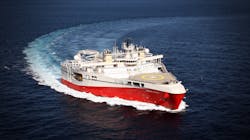PGS awarded Mediterranean 3D survey, details acoustic wavefield trials
Offshore staff
OSLO, Norway — PGS has secured a 3D exploration acquisition contract in the Mediterranean Sea from an unnamed offshore operator.
The company will deploy the Ramform Hyperion, which has been working in the southeastern Mediterranean, to start acquiring the survey shortly, with work due to be completed in mid-January 2023.
“We continue to experience increased exploration activity in this prolific region,” said PGS President and CEO Rune Olav Pedersen.
PGS also has been investigating the feasibility of acquiring seismic data without an active source, instead using the acoustic wavefield generated by a vessel for imaging the subsurface.
Historically, the acoustic wavefield originating from a vessel has been viewed as a source of noise, but trials have recently been conducted in the Barents Sea with different acquisition configurations.
According to PGS, use of active marine seismic sources is not permitted throughout the year or only allowed during short time periods in certain parts of the world. In these areas, using the acoustic signals generated by a vessel as a source may be an alternative option; and using a vessel as a seismic source may also provide a low-cost and low-impact 4D monitoring solution that could enable much more frequent acquisition of time-lapse data, especially over permanent receiver installations.
Three different acquisition setups considered for the Barents Sea trial in PL1083, for partners Lundin, DNO and Petoro, were a towed-streamer configuration, a configuration with a vessel sailing over the top of a towed-streamer spread, and a configuration with a vessel sailing over a PRM system.
The most successful turned out to be the vessel sailing on top of a streamer spread, providing good near-offset coverage and the recording of direct arrivals over a wide range of emission angles. As a result, the acoustic wavefield generated by the vessel could be determined with higher precision over a wide bandwidth, delivering good-quality broadband images.
During the trial, coherent signals were generated in the 2-4 Hz octave right up to 250 Hz in the shallow parts of the section.
The conclusion is that very high-resolution seismic images of the shallow subsurface can be attained using acoustic signals generated by a vessel, due to a combination of the broadband signals the vessel produces and the fact that these signals are generated continuously while the vessel is moving, allowing for dense source-side sampling along the vessel path.
11.28.2022
